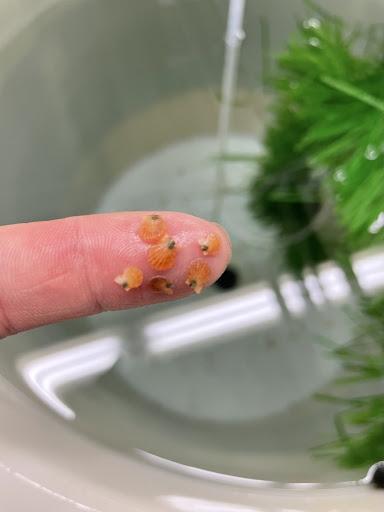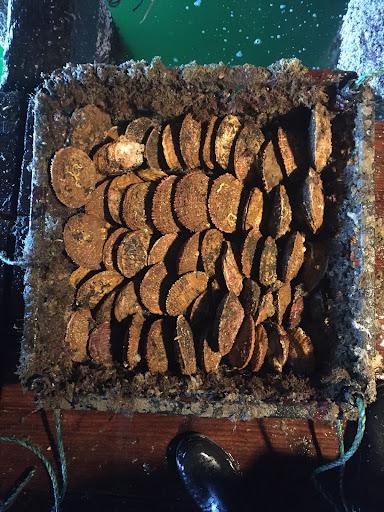Picture a scallop: its marshmallowy-white flesh, buttery taste, delightful lack of bones – all reasons why scallops are one of the most popular seafood items in the world. Now picture a scallop that’s about twice the size of a regular one and known by sport divers to have outstanding, mouthwatering flavor.
That’s the aptly named giant rock scallop, or Crassadoma gigantea. With small quantities available over the years at farmers markets and restaurants on the west coast, It has been a hit with consumers – but only the lucky ones have been able to experience its wonderful flavor. The problem: Until recently, no one has managed to raise large numbers of this deluxe species. “Many have tried using other shellfish technology without a lot of success,” says Luke Gardner, an aquaculture specialist at California Sea Grant. But now, Gardner and his team may have made a breakthrough in rearing large numbers of rock scallop larvae. Their trick? They researched the conventional wisdom about farming this scallop – then did the opposite for some of the things.

The part that we typically eat from the scallop is a big muscle called the adductor muscle which the animal uses to open and close its shell. Most commercially available scallops come from species that are free swimming and propel themselves across the ocean floor by rapidly snapping their shells shut to push out jets of water.
The giant rock scallop – also called purple-hinged rock scallop because of a purple spot near the hinge of its valves – is different. While it can swim freely as a juvenile, it typically settles down before adulthood and cements one of its shells to a rock or pier piling where it spends the remaining decades of its life. (Colorful anemones, sponges, barnacles and algae frequently colonize the rock scallop’s other valve, which often makes these mollusks hard to find, even though they can exceed eight inches in diameter.)
The First Nations people of the Pacific Northwest have traditions of harvesting rock scallops, which live along the west coast from Baja California to Alaska. But there are not enough of them in the wild to sustain a commercial trade, and while wild spat – or juveniles – can be collected for other scallop species, that approach doesn’t work well for giant rock scallops. “Their spawning is too inconsistent and patchy”, says Gardner. This leaves potential aquafarmers with little choice but to raise the larvae from eggs – but whenever they have tried this approach, few larvae survived.

Initially, this also happened to Gardner and his team. With broodstock provided by the Monterey Abalone Company (MAC), which often finds rock scallops in their in-ocean abalone farm, Gardner fertilized and hatched eggs in tanks at San Jose State Universities’ Moss Landing Marine Laboratories (MLML). “The larvae were all dying around day 15,” he recalls. Gardner knew that this wasn’t because there was anything wrong with the eggs themselves. If this had been the case, the larvae wouldn’t have lived even that long. So what was the reason? “We were getting fairly despondent. We couldn't figure out why it wasn't working,” recalls the aquaculture specialist.
The few culture manuals that exist for giant rock scallops follow conventional wisdom from other cultured shellfish, indicating that the larvae needed to be protected from hydrokinetic stress — ie. the water in the tanks should be relatively calm. So Gardner and his team aerated the tanks very carefully. “Fine bubbles introduced at the bottom of the tank were barely breaking the water's surface.”
But after weeks of scooping out dead larvae from the tanks, MLML technician Andrew Kim recalled finding adult scallops in very odd places at the lab such as header tanks where the water flow was high enough to cause significant turbulence. This reminded Kim that rock scallops differ from cultured shellfish in that they live in areas with substantial currents. Kim came up with an idea: Why not mix the water in the entire tank vigorously for a change? Being out of better options, Gardner decided to increase the airflow until the contents of the tanks bubbled like a pot of boiling pasta water.
Lo and behold, the larvae began to survive in much higher numbers. It turns out that “rock scallops like it rough,” muses Gardner. Even rougher than they’ve tried so far, he suspects. “We haven’t found the upper limit yet.”
Then the team discovered yet another trick that helped the larvae grow. It, too, went against prevailing dogma. “We found that feeding less than recommended was beneficial,” says Gardner. This makes sense since rock scallops tend to live on the exposed outer coast – not in bays and estuaries like oysters and clams – where comparatively fewer microalgae float on which rock scallops can feed.

With vigorous water mixing and sparser food, lots more larval rock scallops finally survived until they grew eye spots and got ready to settle and become juveniles.
The next step will be to work out what kind of substrate these mollusks like to colonize in an aquaculture setting, says Gardner. But finally, there may be “a brighter path forward for pushing this highly desirable species toward commercialization in a relatively cost-effective and scalable way,” he and his team conclude in a report.
About California Sea Grant
NOAA’s California Sea Grant College Program funds marine research, education and outreach throughout California. Headquartered at Scripps Institution of Oceanography at the University of California San Diego, California Sea Grant is one of 34 Sea Grant programs in the National Oceanic and Atmospheric Administration (NOAA), U.S. Department of Commerce.